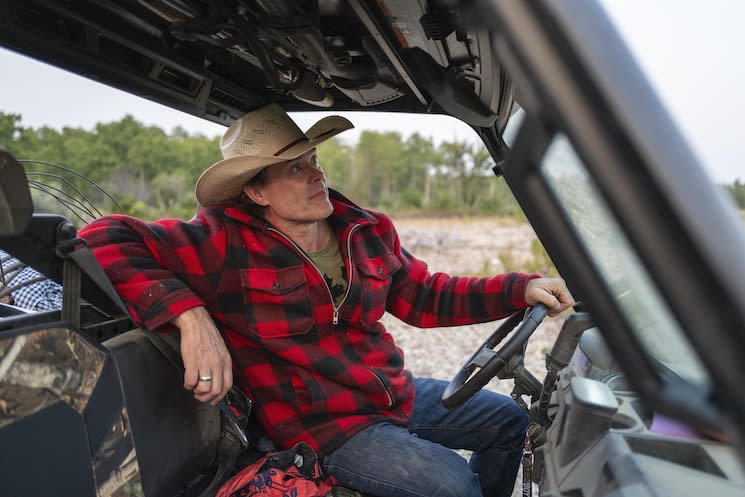Corb Lund wants to welcome you to his living room. His new album, El Viejo, is the next best thing to hanging out at home with him and his finely tuned outlaw country band, the Hurtin' Albertans. They didn't plug in any electric instruments for these sessions, instead playing mandolins, banjos, upright basses and acoustic guitars. These 11 new songs were cut entirely live and often in one take in Lund's living room in Lethbridge, AB, to capture the spirit of his favorite early folk or Johnny Cash records.
"I don't know if it was a budget thing back then, but someone would play a wrong note, or one instrument would be too loud, and they'd just leave that funky stuff in. Now, everything's so pristine," Lund says of bucking country's current trends, just like the pony he sings about on the ramshackle, harmonica-imbued El Viejo highlight "I Had It All."
He tells Exclaim! this while Zooming in from his garage, where a power saw and his motorcycle are visible in the background. He's wearing a grey vest that looks like a sleeveless cardigan, left partly unzipped (all the better to leave the collar turned up), and a black baseball hat emblazoned with "Pro Rodeo" in gold letters (he is, after all, descended from a long line of real-life ranchers ).
Lund has an enthused, quippy way of speaking that makes you want to saddle up — especially as he goes granular when pointing out many modern pop and country songs are made with each musician recording their parts in separate booths. He and his band went against that grain on El Viejo. As he puts it, "Even though, for modern studio recordings, musicians listen to each other on headphones and play along, everything is isolated. That way, if you screw up a guitar lick, you can eliminate it, and go back in to redo it."
He's not turning up his nose though. Lund, after all, got his start founding the DIY metal band the Smalls in 1989. They were influenced by everything from hardcore punk to jazz, along with country. So it shouldn't come as a surprise when he describes his eclectic tastes, and how "I totally dig and respect people who make sonic landscapes, hip-hop producers who make really cool rhythm tracks, and pop songs that have a bunch of stuff going on. But it's just not what I do."
What he and the Hurtin' Albertans did instead was allow the sounds of their instruments to "bleed" into one another. That's the industry term for players' instruments being audible in each others' assigned microphones, instead of those sounds being carefully separated. Too much bleed can be a problem if it interferes with the song's mixing process and the balancing of the levels. As Lund puts it: "If I'm standing right beside the drummer, and he's got a microphone and I got a microphone, if he's drumming loud, then when you go to make the vocal louder, you'd also make the drums louder."
At one point he raises an eyebrow and asks, "Is this too rabbit hole-y?" He seems relieved to hear that it is not only of interest, but also begs the question: why did he want bleed? And how did he get just enough, without ruining the mix?
He begins his answer by recalling how rewarding and visceral it was to record El Viejo with all of his band members. They were seated while strumming or drumming away into carefully placed mics that would make the mix favorable. Lund also outfitted his living room with shoulder-high foam and plywood dividers that helped separate sound, while still allowing eye contact and the reading of facial expressions, rather than a booth that is isolating in every sense of the word.
That way, he and his bandmates could "constantly listen to each other and adjust, getting louder or quieter or more complex or less complex based on the thrust of the song." And to let the bleed be a fun feature instead of a bug, Lund says, "I did a ton of pre-production, in terms of the roadmaps for the songs and the instrumentation. We rehearsed a lot. Because, as you can imagine if you're recording four guys in a room with all that bleed, you can't isolate stuff. And so you kind of got to nail it."
Some bleed adds character, though, especially compared to a studio recording gone sterile. Playing together is "part of music as a communication tool. You're 100 percent listening and responding to each other," Lund says, adding that this way feels "more real. To me, it's the difference between wearing a pair of handmade boots, versus a pair of runners that were stamped in a factory."
